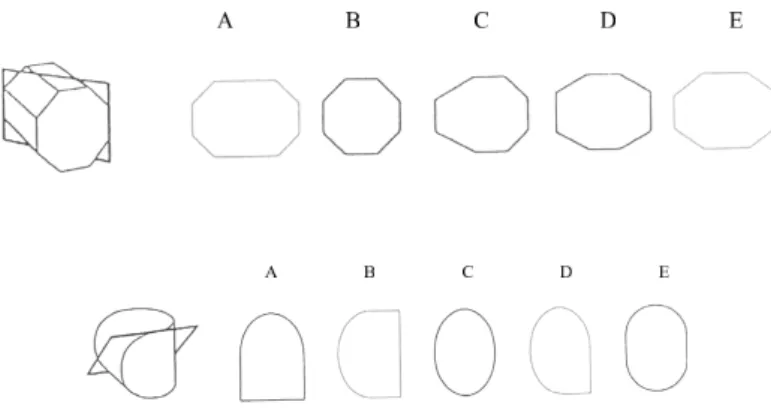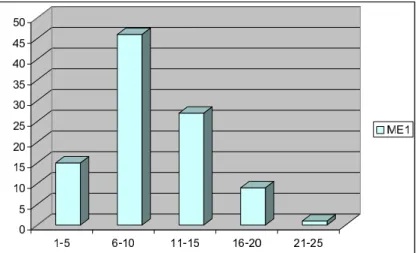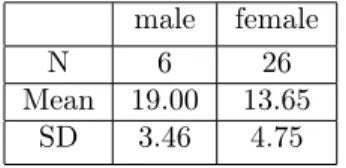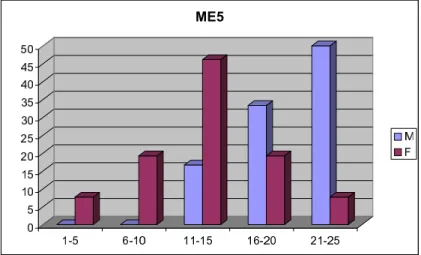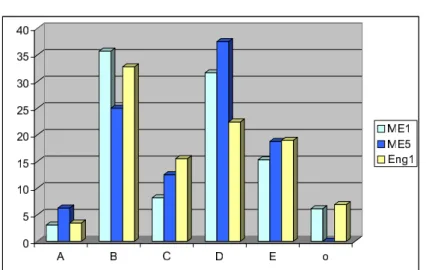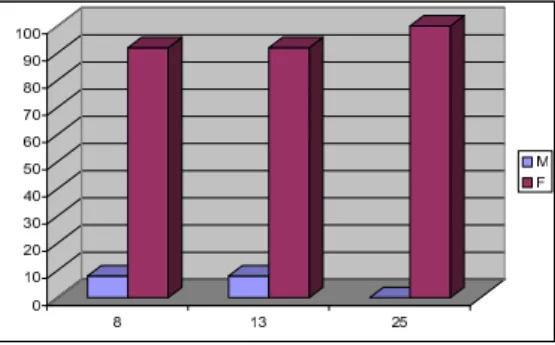Spatial ability of students of mathematics education in Croatia evaluated by the
Mental Cutting Test
Željka Milin Šipuš
a, Aleksandra Čižmešija
baDepartment of Mathematics
Faculty of Science, University of Zagreb, Croatia zeljka.milin-sipus@math.hr
bDepartment of Mathematics
Faculty of Science, University of Zagreb, Croatia aleksandra.cizmesija@math.hr
Submitted December 22, 2011 — Accepted April 11, 2012
Abstract
Spatial ability of students of mathematics education at the Department of Mathematics, University of Zagreb, Croatia, has been evaluated by the Mental Cutting Test (MCT) and the analysis of the results is presented in this paper. Furthermore, the obtained results are compared with the results of engineering students at University of Zagreb. Gender analysis of the results is also presented.
Keywords: Mental Cutting Test, spatial ability, geometry education MSC: 51N05, 97G80, 97D70
1. Introduction
The aim of this paper is to analyze the results of a survey of spatial ability of prospective mathematics teachers at the Department of Mathematics, University of Zagreb, Croatia. With one hundred enrolled students a year, it is the largest institution of higher education in Croatia offering 3-years Bachelor programme and 2-years Master programme in mathematics education. The students have been
http://ami.ektf.hu
203
evaluated by the classical Mental Cutting Test and it is important to emphasize that this is the first time such a survey is carried out in Croatia.
Development of spatial ability is declared as one of the key goals of mathematics education in primary and secondary school all around the world. It is also of central importance for further (higher) education of engineering professions. Therefore, special attention should be paid to improvement and better structuring of spatial ability of prospective mathematics teachers for the compulsory and secondary level education.
Spatial ability can be defined as an intuition about shapes and the relationships among shapes, that is, as the ability to generate, retain, retrieve, and transform well-structured visual (mental) images ([10]). Individuals with well-developed spa- tial ability have a feeling for the geometric aspects of their surroundings and shapes formed by objects in the environment. The most widely recognized model for the development of geometric thinking is described by the so-called van Hiele theory ([21]) and especially can be applied to development of spatial skills. The the- ory identifies five hierarchical developmental levels of individuals’ understanding of spatial ideas. These are visualization, analysis, informal deduction, deduction and rigor. It is expected for students of mathematics education to reach the level of rigor by the end of their study while the compulsory education should provide plenty of opportunities for each student to reach the level of informal deduction.
In Croatia, the new National Framework Curriculum for Early Education, Gen- eral Compulsory and Secondary Education ([5]) has been adopted in August 2010, but has not been fully implemented so far. Anyhow, it is crucial to stress out that this document pays utmost attention to the continuous development of spatial abil- ity, which can be particularly seen in the curriculum areas of Mathematics (strand Shape and space) and Arts (strand Visual arts and design) throughout all four cur- riculum stages. The new curriculum remedies the serious weakness of the present one, in which development of spatial ability has been to certain extent neglected.
For example, there was an obvious discontinuity in learning spatial geometry since 3D shapes have been studied only in the first, fourth and eight grade, mainly by considering their metrical properties (lengths, angles, areas and volumes). Our intention is therefore to analyze spatial skills of students before implementing the new curriculum. We also summarize the expected learning outcomes in spatial geometry now taught in primary and secondary school as well as in pre-service mathematics teacher education. Considering the fact that majority of mathemat- ics education students are female and that males typically outperform females at various spatial ability tests, a gender analysis of the results is presented as well.
2. Theoretical background
Different spatial skills (e.g. mental rotations and mental cutting) can be measured by various tests and for various purposes. Special attention is usually paid to investigation of spatial skills of engineering students (e.g. [7, 13, 15, 16, 17, 18, 19]).
The Mental Cutting Test (MCT) is one of the tests widely used for evaluation
of spatial skills although it was originally developed as an entrance exam to US higher institutions (a sub-set of CEEB Special Aptitude Test in Spatial Relations, 1939). It is the standardized test containing 25 multiple choice items with 5 given alternative answers among which one is correct. Solving time of the test is 20 minutes. Each item is a perspective drawing of a solid body cut by a plane. There are two different types of problems – pattern recognition problems and quantity problems. Pattern recognition problems are problems in which a student should recognize the pattern of the cross section among strongly different alternatives. In quantity problems a student should determine the right relative quantities (ratios of lengths, angles). An example of pattern recognition problems is the item 8 (Fig. 1) and examples of quantity problems are the items 13 and 25 (Fig. 2), see [20].
Figure 1: A pattern recognition problem - item 8
Figure 2: Two quantity problems - items 13 and 25
As it was stated in [20], in order to solve the MCT problems, a student passes through three phases: recognizing the solid from the perspective drawing, cut- ting the solid by the assumed plane and judging the characteristic quantity of the section, if necessary. Failures are mostly based on the fact that students do not recognize spatial forms of the objects. In recent times, besides the classical MCT test, some other tests for evaluating spatial abilities of students were developed in order to meet specific educators needs (e.g. [6, 8]).
Here we also stress out some results from the literature which report on gen- der differences in spatial skills. Decades of intense research on that subject have confirmed that men typically outperform women in spatial ability tests (see e.g.
exhaustive psychological meta-analyses presented in [9, 22] and the recent overview with focus on engineering in [13]). Those differences are most evident in mental ro- tation tasks, even from early ages ([14]). However, it is found that previous spatial activity participation significantly influences performance on spatial ability tests for both sexes ([2]) and that spatial ability can be improved through instruction if appropriate materials and activities are provided ([1, 3, 4, 7, 11, 12, 13, 18]). This includes thematic instruction on spatial geometry topics (such as formal academic workshop and courses described and assessed in [7] and [18]), technical education, as well as non-academic activities (e.g. playing 3D video games, having musical experiences, creating artwork and playing with construction toys) and participa- tion in other activities relying on hand-eye coordination (e.g. playing sports), as described in [13] and in references cited therein. The studies have confirmed the gain for male and female participants, despite initial differences in their achieve- ment. Improvements have been noticed both for pupils ([3]) and older populations ([1, 4, 7, 11, 12, 13, 18]), with persisted retention of effects ([3]).
3. Method
The main focus of the present survey is to analyze spatial skills of prospective teachers of mathematics at the Department of Mathematics, University of Zagreb, Croatia, by means of the Mental Cutting Test. The testing was carried out at the beginning and at the end of the fall semester 2009/2010 for the students of the first year of the Bachelor programme in Mathematics education, ME1 (98 students), and the students of the second year of the Master programme in Mathematics education, ME5 (32 students). The latter students are studying the fifth of five years of the mathematics education programme at the Department of Mathematics, University of Zagreb. We will present the results of the MCT as an one-time test, that is, as the screening instrument of spatial skills of students at the beginning and at near the end of the course of their study. The MCT is also very often used to evaluate the effect of study courses on spatial geometry (e.g. Descriptive geometry) – then it is performed twice, as a pre-test and a post-test, which was not our intention. In order to avoid that the item position in the test influences the scoring result (when solving last items students can be less motivated), the MCT test was distributed to students in four different permutations of items.
Besides this main focus of the survey, our intention was also to compare spatial skills of the two above mentioned groups of students with skills of students of en- gineering faculties at the University of Zagreb, Croatia. Therefore, the MCT was administered to the first-year engineering students of the Faculty of Civil Engineer- ing, Faculty of Architecture, Faculty of Geodesy and Faculty of Mining, Geology and Petroleum Engineering. These faculties train students in solving spatial prob- lems and therefore require well-developed spatial skills, which is especially notable
for one of the faculties which has a test of spatial abilities as a part of the entrance exam.
For better understanding of the context of the survey and its results, we present a brief review of the expected learning outcomes in spatial geometry in Croatian primary and secondary education. According to the present curriculum, upon completion of their primary education (first eight years of schooling), students are expected to be able to recognize basic solids and their nets, reason about simple spatial relationships of points, lines and planes in space, apply the Pythagorean theorem to determine lengths in solids, and calculate surface areas and volumes of right prisms (such as boxes and prisms with an equilateral triangle and a regular hexagon as their bases), spheres, right cones and cylinders.
With respect to primary education, spatial geometry of the common core of ma- jority of secondary mathematics programmes extends only to cover basic properties of skew prisms, pyramids, cones and cylinders.
However, students of the first year entering the higher education in engineering, mathematics and science programmes usually take the stronger track in secondary mathematics education. But still, they do not get any special education in spatial geometry – neither in e.g. analytic space geometry, nor in descriptive geometry during their secondary education. As stated in the Introduction, the major ac- cent in the present curriculum is put on applying trigonometry to solids in order to measure lengths, angles, areas and volumes. Regarding the higher education, ME5 students have met contents in spatial geometry during their university study, namely in courses on analytic geometry, calculus of multivariable real functions (obligatory) and classical differential geometry (elective). The Descriptive geome- try is an one-semester obligatory course given at the fifth year (the second year of the Master programme in Mathematics education). The majority of ME5 students have enrolled in the course of Descriptive geometry during the semester when the MCT test was administered while spatial skills of the first-year students regard only their pre-university education. This applies to all first-year students tested, both to ME1 and to all engineering (Eng) groups.
4. Results
In Table 1 the classical descriptive statistics of the results of students involved in the analysis is given.
Furthermore, in Fig. 3 and Fig. 4 overall results of ME1 and ME5 students are presented, where the achieved points of students are grouped into groups from 1-5 points, 6-10 points, 11-15 points, 16-20 points and 21-25 points. In Fig. 5, in the same diagram, results of ME1, ME5 and students of the best performing engineering faculty Eng1 are presented. Already from Table 1, it can be seen that ME5 students, as well as students of engineering faculties (except Eng4), achieve higher results in MCT then ME1 students. These results are confirmed by applying statistical t-test which shows that there are statistically significant differences between results of ME1 and ME5 students, at the level of significance of
ME1 ME5 Eng1 Eng2 Eng3 Eng4
N 98 32 116 102 204 192
Mean 9.97 14.66 15.83 13.06 11.87 8.71
SD 4.21 4.96 3.86 4.59 5.33 4.06
Median 10 14.5 16 12 11 11.8
Mode 10 18 15 10 6 7
Max 25 23 24 23 25 23
Min 2 2 6 3 2 2
Table 1: Results of the first MCT test for ME1 and Eng groups and of the second MCT test for ME5 group
Figure 3:Percentages of ME1 students who correctly solved certain number of items
p= 0.01. Similarly, there are statistically significant differences between results of ME1 and Eng1, Eng2 and Eng3 students, at the level of significance ofp= 0.01. A possible reason for an evident difference between results of ME1 and ME5 students could be that ME5 is a smaller, more homogeneous group of students motivated in obtaining Master degree, having achieved and improved their spatial skills from various mathematics courses.
Similar comparisons of different groups of engineering students in Austria and Germany can be found in [19].
4.1. Gender analysis of the results
With respect to gender, statistical results are presented in Table 2, Table 3, whereas diagrams in Fig. 6, Fig. 7 present overall scores. Already from these data, it can
Figure 4:Percentages of ME5 students who correctly solved certain number of items
Figure 5: Comparison between ME1 students, ME5 students and Eng1 students in number of correctly solved items
male female
N 29 69
Mean 12.03 9.10
SD 4.85 3.60
Table 2: Statistics of results with respect to gender of ME1 students
male female
N 6 26
Mean 19.00 13.65
SD 3.46 4.75
Table 3: Statistics of results with respect to gender of ME5 students
be seen that male students are performing better in the MCT than their female colleagues which was confirmed by applying statisticalt-test. It is shown for both ME1 and ME5 group of mathematics education students that, at the level of signif- icance of 0.01, male students perform statistically significantly better then female students. This result agrees with the result obtained in [6, 15, 19]. It is of great importance to be aware of this result since mathematics education female students at the Department of Mathematics in Zagreb outnumber their colleague male stu- dents (in the observed year 2009/2010, percentage of female students was 70% at the first year and 81% at the fifth year).
In Table 4, gender differences of students of the best performing engineering faculty Eng1 are presented. Comparing ME1 and ME5 female students with female students from the group Eng1 we can conclude again that female students of the best performing engineering faculty Eng1 are performing statistically significantly better at the level of significance of 0.01.
male female
N 50 66
Mean 17.08 14.8
SD 3.37 3.95
Table 4: Statistics of results with respect to gender of Eng1 stu- dents
Some further evidence on gender differences is presented in the next section.
5. Items analysis
In this section, the analysis of the items 8, 13 and 25 for ME1, ME5 and Eng1 students is given. Some of these items are included in the analysis in [17, 19, 20]. The analysis involves the analysis of distractors (distribution of answers) with spacial attention to gender differences.
Distribution of answers for the item 8 is given in Fig. 8. Already from the diagram, it can be seen that the students from the group Eng1 are very confident with the correct answer, whereas the first-year mathematics education students make the typical mistake by marking A as the correct answer more often than D.
Figure 6: Gender comparison – number of correctly solved items by female and male students of the group ME1
Figure 7: Gender comparison – number of correctly solved items by female and male students of the group ME5
As it is stated in [17], the natural explanation for this choice is that a curved object usually yields curved cuts.
Distribution of answers for the item 13 is given in Fig. 9. Being a quantity problem, item 13 turns out to be difficult. But again, students from the group Eng1 are confident with the correct answer, although the typical mistake A appears as well (as in [20]). The ME1 students and the ME5 students in much higher percentage mark incorrect answers A as correct, whereas ME1 students mark as correct also the answer C.
Figure 8: Item 8 – distribution of answers in percentages of ME1, ME5 and Eng1 students, correct answer is D
Figure 9: Item 13 – distribution of answers in percentages of ME1, ME5 and Eng1 students, correct answer is E
Distribution of answers for the item 25 is given in Fig. 10. It can be noticed that more students in all groups, compared to other problems, did not try to answer the problem. Item 25 can be considered as a pattern recognition and quantity problem at the same time since many students failed in recognizing the pattern of the cross section. There is no strongly dominating answer and even three incorrect answers (B, D, E) are chosen more often than the correct answer C. In answers B and D one should decide on the pattern of the section, where the answer B offers the front view of the object and the answer D the figure which is not symmetrical.
Figure 10: Item 25 – distribution of answers in percentages of ME1, ME5 and Eng1 students, correct answer is C
Furthermore, even the students who decided correctly on the pattern, chose more often incorrect answer E than C. Low results of the groups ME1 and Eng1 can be explained as in [19], that a student needs not only the intuitive spatial ability, but some geometrical consideration as well, but this explanation cannot be applied to the group ME5. The ME5 students have acquired formal knowledge sufficient for solving this item, so possible explanation of their failure on this problem lies in their lacking abilities to analyze and make connections to required knowledge, which was even more stressed in testing situation with little time available (less than one minute per item on average).
Analysis with respect to gender can be found in Fig. 11 and Fig. 12. In these figures, results on choosing the typical mistakes by male and female students in percentages of students who failed the problem are given. It can be seen that female students more often chose the typical mistakes. Similar results of the first- year engineering students at Faculty of Engineering, Szent István University in Hungary can be found in [17].
6. Conclusion
The Mental Cutting Test was performed as a screening test of spatial abilities of students of mathematics education at the Department of Mathematics, Univer- sity of Zagreb. The survey was motivated by the changes planned in mathemat- ics curriculum for the general compulsory and secondary education. Throughout the present mathematics curriculum, educational goals in spatial geometry are ne- glected, which has been now changed in the new curriculum. Therefore, special
Figure 11: Typical mistakes by male and female students of ME1 in percentages of students who failed problems 8, 13 and 25
Figure 12: Typical mistakes by male and female students of ME5 in percentages of students who failed the problem 8, 13 and 25
attention should be paid to pre-service education of prospective teachers of math- ematics, since, hopefully, they will have more instructional time to develop spatial abilities of their students.
As a screening test of the present situation, evaluation of spatial abilities by MCT gave the following results:
• Significant difference in results between the first-year ME1 students and the results of peer-students at engineering faculties at University of Zagreb.
• Significant difference in results of female and male students of mathematics education ME1 and ME5.
• Significant difference in results between the first-year ME1 students and the fifth-year ME5 students.
• Significant difference in results of female students of mathematics education ME1, ME5 and female students of the best performing engineering faculty Eng1.
Since the survey was administered to the students at very beginning of their university study (excluding ME5 group), the results obtained primarily reflect their spatial abilities gained through previous education. They clearly show that changes proposed in the geometry strand of the new curriculum are more than welcome. In order to use their potential and to offer formal support to foster the acquisition of spatial skills, teaching of topics in spatial geometry should provide opportunities to students to connect the underlying concepts, reason about them and to develop spatial skills continuously during all educational stages. Topics in spatial geometry are suggested to be firmly connected to real life objects and situations and to other curriculum areas as well. During all educational stages, teaching strategies should be designed to involve many student hands-on group and individual activities with manipulatives (e.g. handheld models) and technology (e.g. 2D and 3D models in Dynamic Geometry Software) that encourage students to create, explore, transform and relate 2D and 3D geometric shapes. This particularly goes to female students who are of special concern regarding their shown average lower achievements.
Acknowledgements. The authors thank the professors and assistants of the course Descriptive geometry at the Faculty of Civil Engineering, Faculty of Ar- chitecture, Faculty of Geodesy and Faculty of Mining, Geology and Petroleum Engineering, University of Zagreb, for motivating their students and helping to carry out the testing at these faculties. Furthermore, they wish to express their gratitude to professor Miljenko Huzak, Department of Mathematics, Faculty of Sci- ence, University of Zagreb, in helping them to carry out the statistical analysis of the results. They also thank the anonymous referee for valuable suggestions that improved the final version of the paper.
References
[1] Alias, M., Black, T. R., Gray, D. E., Effect of Instruction on Spatial Visualisation Ability in Civil Engineering Students, International Education Journal, 3(1), (2002), http://iej.cjb.net
[2] Baenninger, M., Newcombe, N.,The Role of Experience in Spatial Test Performance:
A Meta-analysis, Sex Roles, 20 (1989), 5–6, 327–344.
[3] Ben-Chaim, D., Lappan, G., Houang, R. T., The Effect of Instruction on Spatial Visualization Skills of Middle School Boys and Girls, American Educational Research Journal, 25 (1988), 51–71.
[4] Burnet, S. A., Lane, D. M.,Effects of Academic Instruction on Spatial Visualization, Intelligence 4 (1980), 233–242.
[5] Nacionalni okvirni kurikulum za predškolski odgoj i obrazovanje te opće obvezno i srednjoškolsko obrazovanje [National Framework Curriculum for Early Education, General Compulsory and Secondary Education], http://public.mzos.hr/Default.aspx?sec=2685.
[6] Gorska, R., Juščakova, Z.,A Pilot Study of a New Testing Method for Spatial Abilities Evaluation, Jour. Geom. Graph.,7(2003), 237–246.
[7] Hsi, S., Linn, M. C., Bell, J. E.,The Role of Spatial Reasoning in Engineering and the Design of Spatial Instruction, Journal of Engineering Education,86(2) (1997), 151–158.
[8] Juščakova, Z., Gorska, R.,TPS Test Development and Application into Research on Spatial Abilities, Jour. Geom. Graph.,11(2007), 223–236.
[9] Linn, M. C., Petersen, A. C.,Emergence and Characterization of Sex Differences in Spatial Ability: A Meta-analysis, Child Development, 56(6) (1985), 1479–1498.
[10] Lohman, D. F., Spatial Ability and G., in I. Dennis, P. Tapsfield (Eds.), Human Abilities: Their Nature and Assessment, Hillsdale, NJ: Erlbaum, 97–116, 1996.
[11] Lord, T. R.,Enhancing the Visuo-spatial Aptitude of Students, Journal of Research in Science Teaching 22 (1985), 395–405.
[12] Merrill, C., Devine, K. L., Brown, J. W., and Brown, R. A.,Improving Geometric and Trigonometric Knowledge and Skill for High School Mathematics Teachers: A Professional Development Partnership, The Journal of Technology Studies, 36(2), (2010), 20–30.
[13] Metz, S. S., Donohue, S., and Moore, C.,Spatial Skills: A Focus on Gender and En- gineering, In B. Bogue, E. Cady (Eds.)Apply Research to Practice (ARP) Resources, 2012, http://www.engr.psu.edu/AWE/ARPResources.aspx
[14] Moore, D. S., Johnson, S. P.,Mental Rotation in Human Infants: A Sex Difference, Psychological Science, 19(11) (2008), 1063–1066.
[15] Németh, B., Hoffmann, M.,Gender Differences in Spatial Visualization among En- gineering Students, Ann. Math. Inform., Vol.33(2006), 169–174.
[16] Németh, B., Measurement of the Development of Spatial Ability by Mental Cutting Test, Ann. Math. Inform., Vol.34(2007), 123–128.
[17] Németh, B., Sörös, Cs., Hoffmann, M.,Typical Mistakes in Mental Cutting Test and Their Consequences in Gender Differences, Teaching Mathematics and Computer Science,5(2) (2007), 385–392.
[18] Sorby, S., Educational Research in Developing 3-D Spatial Skills for Engineering Students, International Journal of Science Education,31(3) (2009), 459–480.
[19] Tsutsumi E., Schröcker H.-P., Stachel H., Weiss G.,Evaluation of Students’ Spatial Abilities in Austria and Germany, Jour. Geom. Graph.,9(2005), 107–117.
[20] Tsutsumi E., Shiina K., Suzaki A., Yamanouchi K., Saito T., Suzuki K.,A Mental Cutting Test on Female Students Using a Stereographic System, Jour. Geom. Graph., 3(1999), 111–119.
[21] van Hiele, P. M.,De problematick van het inzicht gedmonstreed van het inzicht van schodkindren in meetkundeleerstof [The problem of Insight in Connection with School Children’s Insight into the Subject Matter of Geometry], Doctoral dissertation, Uni- versity of Utrecht, 1957.
[22] Voyer, D., Voyer, S., Bryden, M. P.,Magnitude of Sex Differences in Spatial Abilities:
A Meta-analysis and Consideration of Critical Variables, Psychological Bulletin, 117 (1995), 250–270.
